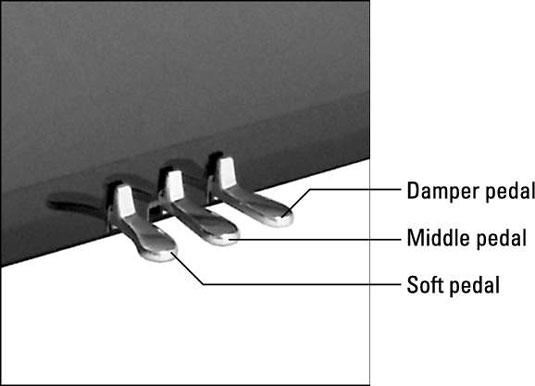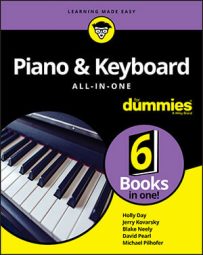If you are planning to learn the intricacies of piano or keyboard, the pedals come in handy for developing your own unique sound. The information here gives you the basics on how to use the pedals on your instrument.
Piano pedals
Most pianos come equipped with three pedals.

To the far right is the damper pedal(or sustain pedal). When you hold this pedal down, the dampers — mechanisms that mute the strings — are moved away from the strings, allowing the strings to ring until you release the pedal, the sound gradually fades away, or you fall asleep and fall off the bench.
You don’t have to use the damper pedal every time you play a note because each key has its own damper.
Most musicians, and even nonmusicians who purport to know something about music, refer to the damper pedal as “the pedal” because it’s the most popular and most frequently used pedal.
To the far left is the soft pedal. This pedal works differently in uprights and grands, but you use it to make your piano sound softer.
The Italian name for the soft pedal is the una corda. On grand pianos, pressing down this pedal causes the entire set of hammers inside the piano to shift slightly to the side. When you play on any of the keys with the pedal down, the hammers hit only one string, or una corda, instead of the usual three.
In the middle is the middle pedal, or sostenuto pedal. This pedal appears on many pianos, but not all. Unlike the damper pedal, which sustains all notes being played, the middle pedal allows you to sustain a specific note, or group of notes, while you continue playing other notes normally.
Simultaneously hold down the middle pedal and play a key on the piano and the sound sustains. Now, quickly play other notes and you’ll notice they don’t sustain. Pretty cool, right? Well, pretty difficult, too — especially in the midst of playing Rachmaninoff’s Piano Concerto No. 3. Many piano manufacturers now opt to save money and omit this pedal.
On some upright pianos, the middle pedal is called a practice pedal and has an entirely different function: It inserts a layer of felt between the hammers and strings to make the sound much softer and more muffled. This pedal allows you to practice late at night without disturbing others, so you might call it the good neighbor pedal.
Digital keyboard pedals
The most common digital keyboard pedals are the sustain pedal (which performs the same function as on an acoustic piano) and the volume pedal (which increases or decreases the volume).
Nearly every keyboard comes with a plug-in sustain pedal; it doesn’t move any dampers or shift any keys because there are no real strings inside a digital keyboard. Instead, the pedal sends an electronic signal to the brain of your keyboard, telling it to sustain the notes or increase or decrease the volume if you’re using a volume pedal.
Other pedals you can add to your electric keyboard control such things as vibrato, which makes the note sound as if it’s warbling; program changes; and special effects.
You can sample these various pedals and decide which ones are right for you at your local electric keyboard dealer. The salesperson should be more than happy to show you a whole line of different pedals, hoping that you want to spend even more money than you already are for the keyboard itself.
If you’re unsure about extra pedals, hold off on buying them. You can always buy and install them later, when you know that you’ll use them. The plug for all pedals and most other accessories is a standard size, making additions a snap.

